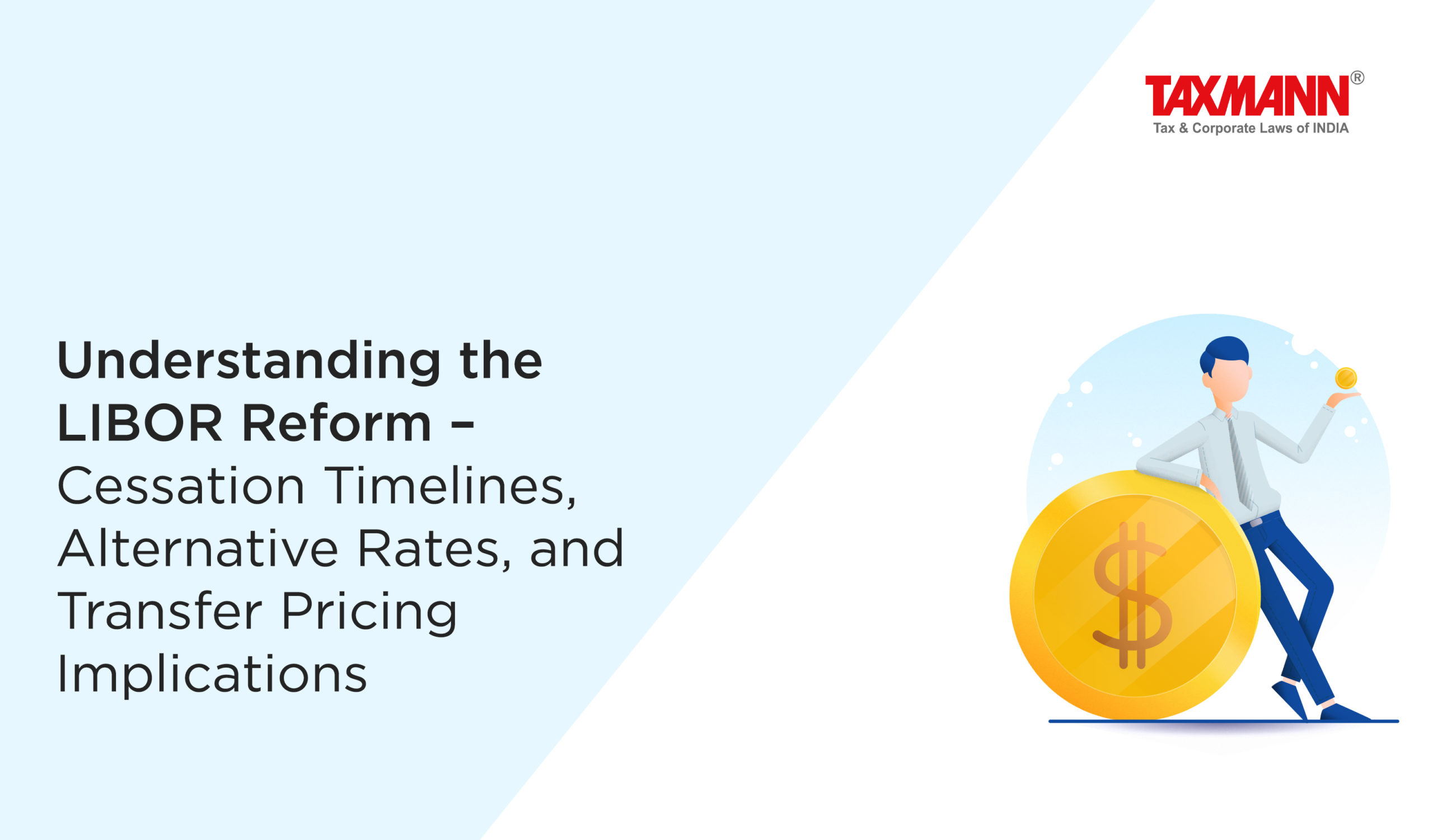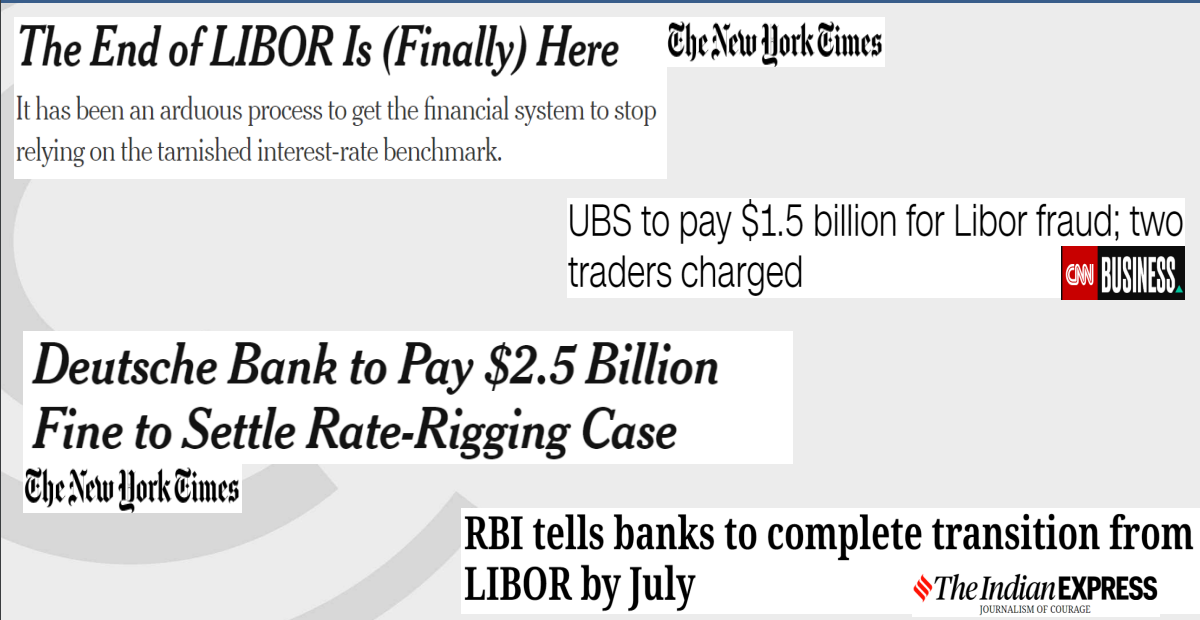Understanding the LIBOR Reform – Cessation Timelines, Alternative Rates, and Transfer Pricing Implications
- Blog|Transfer Pricing|
- 5 Min Read
- By Taxmann
- |
- Last Updated on 31 July, 2023

Table of Contents
- LIBOR – A Brief Background
- Need for LIBOR Reform
- LIBOR Cessation Timelines
- Alternative Reference Rates (ARRs) to LIBOR
- Transfer Pricing Implications
- Way Forward
1. LIBOR – A Brief Background
- London Interbank Offer Rate (LIBOR) – A benchmark reference rate for floating rate transactions on the London Inter-Bank Market
- Used to calculate intertest rates for derivatives, government and corporate debt, commercial loans, residential loans, etc
- Linked to more than USD 400 trillion of financial transactions globally
- Most widely used for short term interest rates
- Been available in 5 currencies (USD, GBP, EUR, CHF, YEN) and for 7 different type of maturities (overnight to 12 months)
1.1 How is LIBOR Calculated?
- Panel Banks estimate the rate that would be charged to borrow from other banks on an unsecured basis (from overnight to 12 months)
- Each day submissions received from 18 international banks
- Four highest and lowest submissions stripped out before calculating an average
2. Need for LIBOR Reform
2.1 Need for LIBOR Reforms
2008 Financial Crisis – Aftermath
- Significant reduction in transaction data in unsecured inter-bank lending market
- Regulators were concerned about the long term sustainability
2012 LIBOR Scandal
- Manipulation / Rigging of interest rates by Leading Banks
- Barclays was a key player in this complicated scam.
2.2 Fall of LIBOR

3. LIBOR Cessation Timelines
- Financial Conduct Authority (FCA) – on 5th March 2021, announced that all LIBOR settings will either cease to be provided by any administrator or no longer be representative:
- Immediately after 31st December 2021, in the case of all EUR, GBP, CHF and JPY yen settings, and the 1-week and 2-month US dollar settings; and
- Immediately after 30th June 2023, in the case of the remaining US dollar settings
- Synthetic versions of one-, three- and six-month USD LIBORs will be available until 30 September These will be published by ICE Benchmark Administration Limited in the same place and at the same times as the original USD LIBORs but will be constituted from different data
4. Alternative Reference Rates (ARRs) to LIBOR
4.1 Alternate Reference Rate (ARR’s)
With LIBOR winding down, markets have been making the shift toward Alternative Reference Rates (ARRs)
Table: Currency-wise ARRs
| LIBOR currency | Proposed Replacement | Transaction Type |
| USD | SOFR – Secure Overnight Funding Rate | Secured |
| GBP | SONIA – Sterling Overnight Index Average | Unsecured |
| Euro | ESTR – Euro Short Term Rate | Unsecured |
| CHF | SARON – Swiss Average Rate Overnight | Secured |
| JPY | TONAR – Tokyo Overnight Average Rate | Unsecured |
4.2 LIBOR v. ARRs
Table: Key difference between LIBOR & ARRs
| Parameter | LIBOR | ARR |
| Calculation Methodology | Submission from panel banks | Based on actual transactions in liquid markets |
| Term Structure | Term structure with seven different forward-looking tenors, from overnight to 12 months | Backward-looking overnight rates |
| Credit Risk Premium | Reflects cost of borrowing by panel banks and thus, includes credit premium component | Are proxies to risk-free rates and have no credit premium |
| Timing of rate publication | Based on consistent methodology across the 5 currencies and published at the same time | ARRs have different methodologies and publication timelines for each currency |
4.3 Credit Spread Adjustment
- A spread adjustment is meant to minimize the difference between LIBOR and SOFR
- ISDA (International Swaps and Derivatives Associations) – has prescribed using 5- year historical median difference between LIBOR and SOFR compounded-in-arrears to arrive at the static spread adjustment
- The spread adjustment will be one time and not dynamic in nature
- Bloomberg has been selected to calculate and publish the fallback rates and spreads
- Commercial tools/databases are available in the market that can assist with the spread adjustment
4.4 RBI’s Stance on Libor
- In 2020, the RBI requested banks to address risks arising from the cessation of LIBOR, including preparation for the adoption of the ARRs
- Cease using the Mumbai Interbank Forward Outright Rate (MIFOR- a benchmark for setting prices on forward-rate agreements and derivative), which references the LIBOR
- Undertake a comprehensive review of all direct and indirect LIBOR exposures and put in place a framework to mitigate risks arising from such exposures
- 12th May, 2023 – “Banks/FIs are expected to have developed the systems and processes to manage the complete transition away from LIBOR from July 1, 2023.”
5. Transfer Pricing Implications
5.1 Inter-Company Agreements
- Existing arrangements to be evaluated
- Companies need to consider alternative base rates to replace LIBOR
- Fallback clauses to be implemented in the intercompany agreements
- The cessation of LIBOR settings may impact the viability of the document if adequate fallback language not be included for interest payment calculations
- Tax authorities might still argue that it is not sufficient to solely renegotiate the base rate relying on third party comparisons
5.2 APAs
- Transition of LIBOR may have impact on concluded APAs ( (1) Loan and (2) Corporate Guarantee Transactions)
- Income Tax Rules require revision of APAs in case there is change in any “critical assumptions” subject to which the APA was entered into
- Rule 10M of the Income Tax Rules prescribe:
- (4) In case there is a change in any of the critical assumptions or failure to meet the conditions subject to which the agreement has been entered into, the agreement can be revised or cancelled, as the case may be.
- (5) The assessee which has entered into an agreement shall give a notice in writing of such change in any of the critical assumptions or failure to meet conditions to the Director General of Income-tax (International Taxation) as soon as it is practicable to do so.”
- Unless APA includes appropriately defined fallback clauses, cessation of LIBOR may amount to material change impacting critical assumptions
5.3 Safe Harbour Rules
- Section 92CB read Rule 10TB prescribes Safe Harbour rules for transfer pricing purposes. Rules provide following margins in respect of loan transaction
| CRISIL credit rating of AE | Safe Harbour rules – Interest greater than 6 months LIBOR as on 30 September plus |
| Between AAA to A or its equivalent | 150 basis points |
| BB-, BBB or BBB+ or its equivalent | 300 basis points |
| Between BB to B or its equivalent | 450 basis points |
| Between C to D or its equivalent | 600 basis points |
| Where credit rating of the AE is not available and the amount of loan advanced to the AE including loans to all AEs does not exceed a sum equivalent to one hundred crore Indian rupees in the aggregate as on 31st March of the relevant previous year | 400 basis points |
- Revised Safe Harbour Rules awaited
6. Way Forward
- The recommended first step is for companies to identify intercompany agreements containing LIBOR references and modify those agreements
- To the extent LIBOR is referenced in existing agreements, appropriate fallback language should be included – For both Related and Third party Agreements
- Apply globally accepted transition methodologies from LIBOR to ARR
- Robust documentation along with detailed benchmarking and backup should be maintained to explain any position to the tax office if challenged
Disclaimer: The content/information published on the website is only for general information of the user and shall not be construed as legal advice. While the Taxmann has exercised reasonable efforts to ensure the veracity of information/content published, Taxmann shall be under no liability in any manner whatsoever for incorrect information, if any.

Taxmann Publications has a dedicated in-house Research & Editorial Team. This team consists of a team of Chartered Accountants, Company Secretaries, and Lawyers. This team works under the guidance and supervision of editor-in-chief Mr Rakesh Bhargava.
The Research and Editorial Team is responsible for developing reliable and accurate content for the readers. The team follows the six-sigma approach to achieve the benchmark of zero error in its publications and research platforms. The team ensures that the following publication guidelines are thoroughly followed while developing the content:
- The statutory material is obtained only from the authorized and reliable sources
- All the latest developments in the judicial and legislative fields are covered
- Prepare the analytical write-ups on current, controversial, and important issues to help the readers to understand the concept and its implications
- Every content published by Taxmann is complete, accurate and lucid
- All evidence-based statements are supported with proper reference to Section, Circular No., Notification No. or citations
- The golden rules of grammar, style and consistency are thoroughly followed
- Font and size that’s easy to read and remain consistent across all imprint and digital publications are applied






